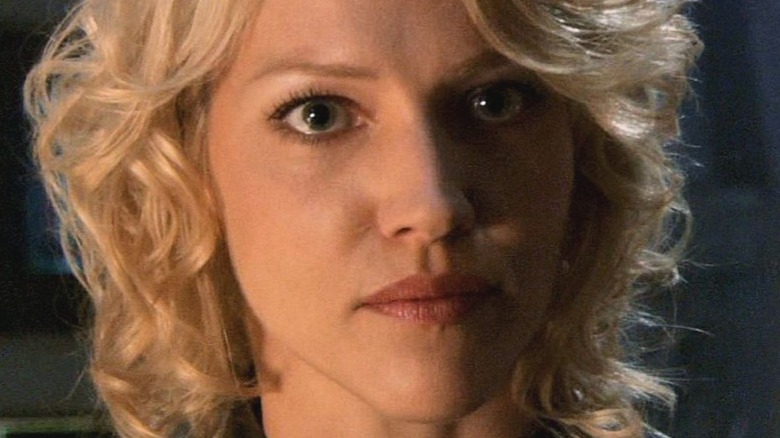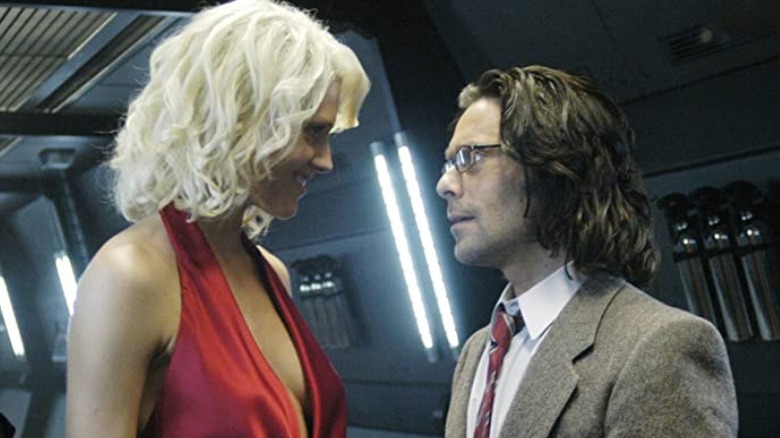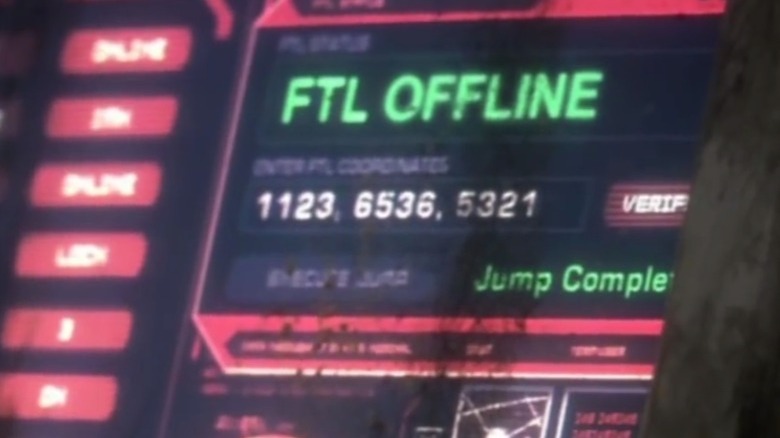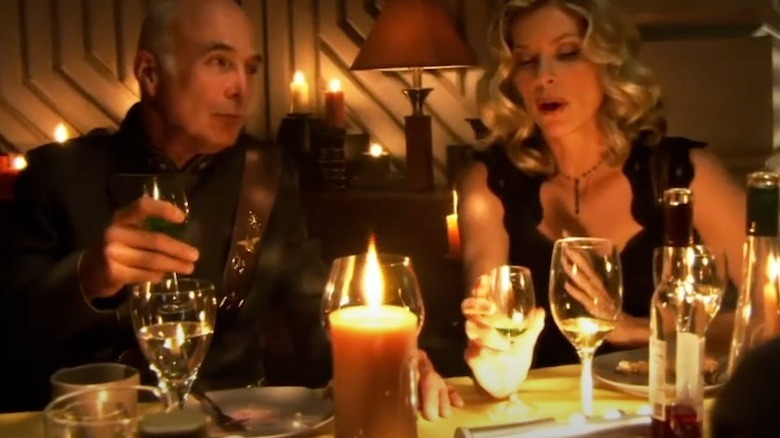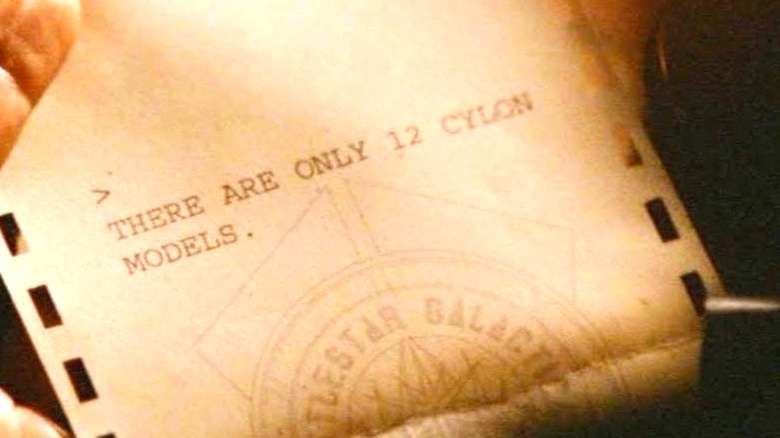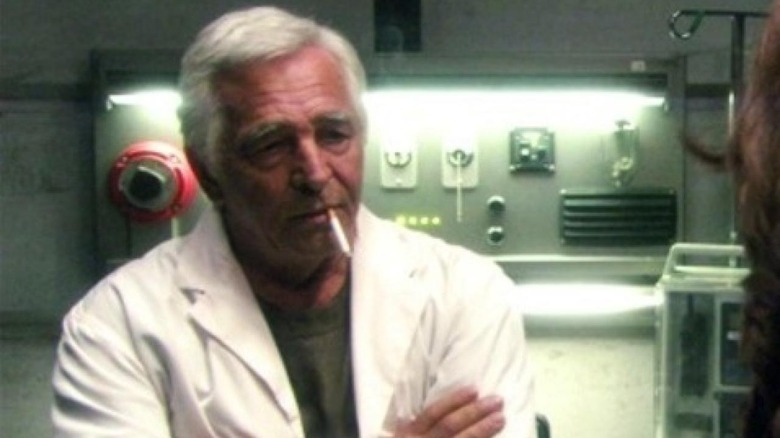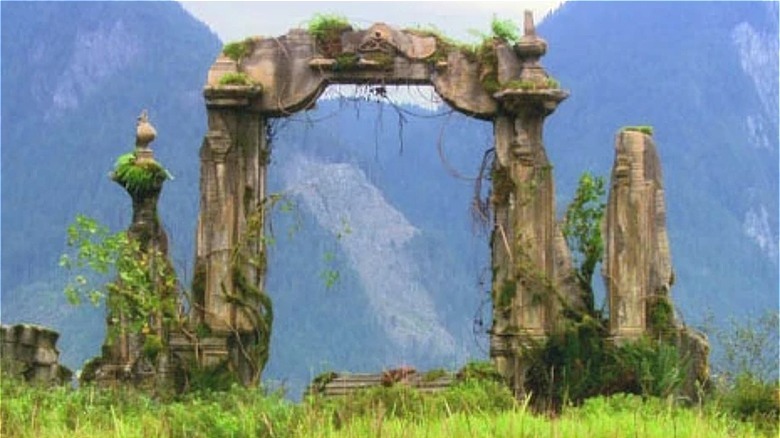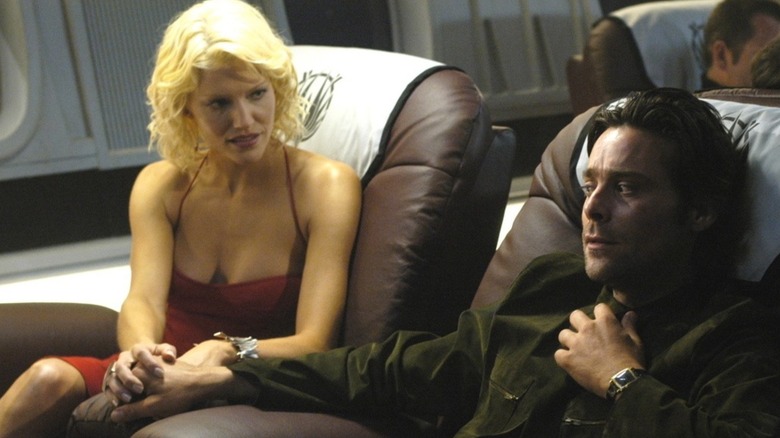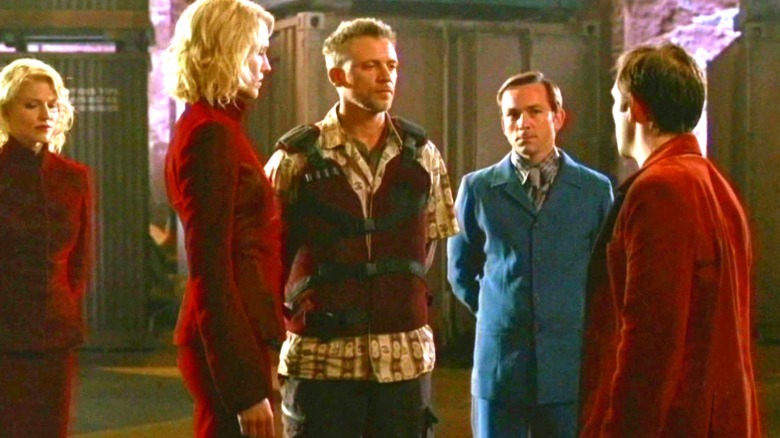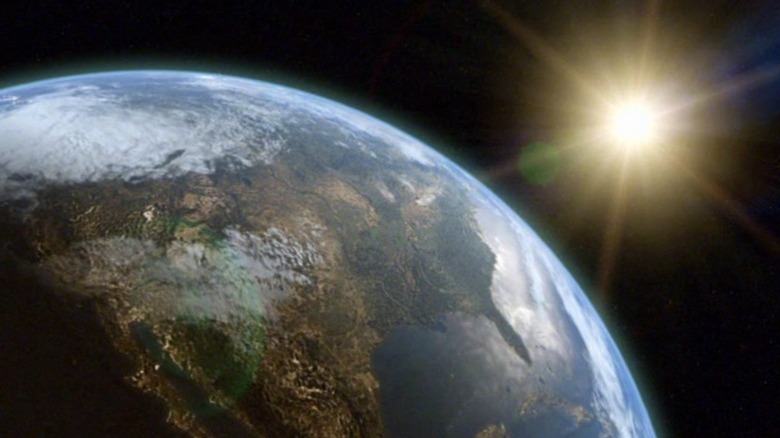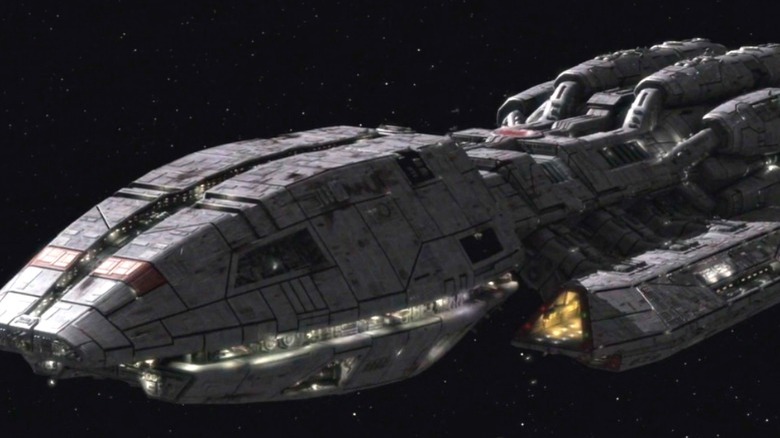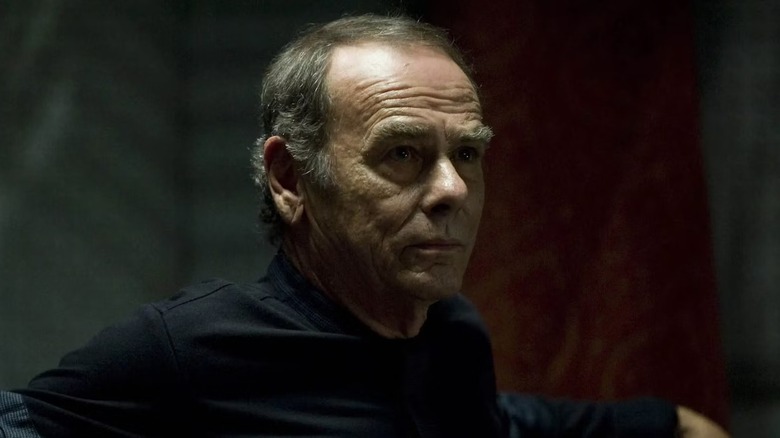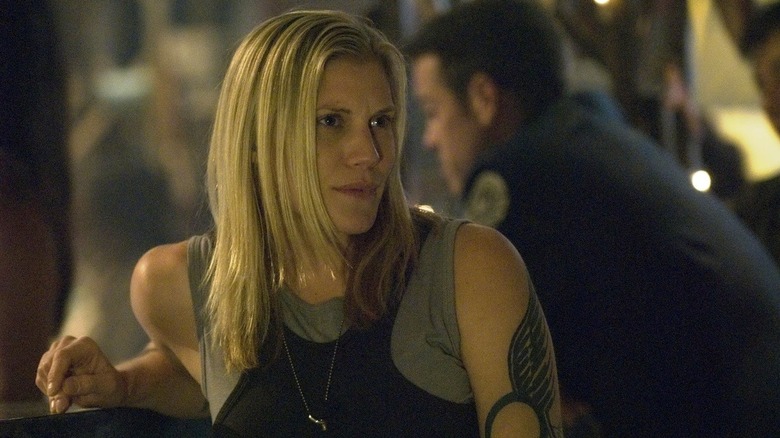Questionable Things We Ignore In Battlestar Galactica
In a world where AI phone calls can sound unsettlingly human and deep fakes are practically indiscernible from genuine images, the world of "Battlestar Galactica" seems a little less far off than it once did. The story follows a band of around 50,000 human survivors of a nuclear attack as they search for a new planet while being pursued by a cybernetic race of evil-doers known as the Cylons. The original series aired back in 1978, but it didn't last very long. The property was resurrected in the '00s, first with a miniseries and then a critically acclaimed full-length series that is still loved to this day.
Created by Ronald D. Moore, the reboot series is now part of sci-fi history. However, while it's been widely lauded for a level of storytelling rarely seen in the science fiction genre, no show is perfect. From machines with murky motivations to unsatisfying plot twists that leave viewers wanting more, we're taking a closer look at the most questionable things in "Battlestar Galactica."
Baltar and Six's relationship
The world of "Battlestar Galactica" is populated with complicated couples, from the interspecies pairing of Sharon and Helo to the millenia-spanning bad romance of Ellen and Saul Tigh. Perhaps the most questionable coupling in the series is that of Gaius Baltar and Caprica-Six, the Cylon responsible for finagling her way into the Colonial defense mainframe and making the genocide of the human race possible. Baltar's status as a notorious playboy is clear throughout the series. Caprica-Six seems to be the one woman capable of overlooking his unreliable behavior, having fallen in love with him during their time together, despite his many personality flaws.
Throughout the course of the series, it's established that Six and Baltar had been seeing each other for two years before the attack on the colonies, with Baltar working under the assumption that her inquiries into the defense mainframe were to gain a corporate advantage. Despite the fact that he has other lovers, Six has a key to his house on Caprica, opening his front door during his virtual interview and later appearing in his bedroom. And yet, in all their time together, Baltar doesn't ever learn her name, something that's stated explicitly in "Daybreak Part 1." Some fans have speculated that Six was intentionally evasive when asked, and — self-absorbed genius that he is — Baltar never pressed the issue. Judging by his less-than-scrupulous bedroom habits, Baltar unintentionally committing treason for a woman whose name he didn't bother to learn is pretty on-brand.
How the FTL drive works
Faster-than-light propulsion technology would be essential for any spacefaring civilization, and while real-world scientists have yet to crack the code, plenty of versions of FTL tech have been dreamed up in the world of science fiction, from Starfleet's warp drive in the "Star Trek" universe to the quantum reactor of "The Orville." But, unlike those technologies, which seem to warp space around the vessels, the FTL drive technology in "Battlestar Galactica" works by jumping a ship from one point to another. The Colonials come to rely heavily on their FTL drives while on the run from the Cylons, but it's never really made clear exactly how this tech works or why spooling the drive is so complicated on the Galactica, but not the Raptors. However, there are a few indications.
During the miniseries, when the Galactica plots a dangerous jump to Ragnar Station, Tigh expresses concern about the distance falling "over the Red Line" — a reference to the fact that calculations become less reliable when a certain distance is reached. As the ship makes the jump, Cally is noticeably unsettled, and the camera zoom changing around her indicates that passengers aboard an FTL vessel can sense a change during the jump. While the details remain a little foggy during the series, the "Battlestar Galactica" series bible gives a more detailed explanation of the drive's technology, explaining that when the drive folds space, a vessel "literally transfers itself between two distant points which are momentarily brought together." The bible also clarifies that the Galactica's jump prep takes longer due to the age of the technology.
The food situation
One of the most realistic things that happens in "Battlestar Galactica" is the Colonial fleet's food supply dwindling, even if they do seem to have an irrationally endless supply of booze. Baltar first mentions the potential for a food shortage in the episode "Water," when he outlines the extensive food and water supplies the fleet will need to survive. But exactly where and how that food is getting produced remains something of a mystery.
Since there doesn't seem to be a serious food shortage for most of the show's first three seasons, this implies that somewhere in the Colonial fleet there is at least one ship dedicated to food production. A ship that might be capable of growing food is Cloud 9, the luxury vessel with live plants and an artificial outdoor habitat, and it's more than possible that the fleet contains more ships like the Botanical Cruiser, the sublight ship that didn't make it through the miniseries.
The fleet's food supply gets even more questionable when their food processing systems become contaminated in "The Passage," which implies that most of their food is coming from the same source or stored in the same location. The fleet is saved from looming starvation after the viper pilots manage to heroically navigate the ships through a dangerous star cluster, leading them to an algae planet. Although they manage to harvest enough algae to survive, most of their food and even their coffee is now algae-based. Let's hope they at least had some hot sauce stashed away for their algae-based noodles.
The shape of the paper
As the Colonials belong to an ancient civilization, it makes sense that many things would be different from what we're familiar with. If anything, it's surprising how similar the fashions, faiths, and customs of the Colonials are to life on modern Earth. There is one very distinct and arguably impractical difference that stands out throughout the series: Colonial paper has the corners cut off.
This Colonial corner-cutting can be seen throughout the series, starting mere seconds into the miniseries as the courier officer at Armistice Station surveys a technical document depicting specifications on Cylon centurion models. It comes up again at the end of the miniseries when Adama reads a computer printout found in his quarters revealing there are only 12 Cylon models. Throughout the series, examples of this corner-cutting can be seen in everything from books to photographs to the Colonial equivalent of Post-It notes. While this could be a popular design trend, it hardly seems practical or cost-effective to cut the corners off of every paper product in the Colonies, from military to civilian. Fans have come up with a host of theories to explain it, with some even speculating that the missing corners could have a religious or superstitious meaning.
Patrick Di Justo, who co-authored "The Science of Battlestar Galactica," may have resolved the mystery once. He told Wired: "I think that was just a joke about having to cut corners on the show." If true, this adds a meta meaning to Adama's conversation with Chief about the Galactica's original engineers cutting corners during her creation.
The cigarette situation
Life is pretty rough in the Colonial fleet, which at various times faces serious shortages of food, water, pilots, and tylium to fuel their ships. But the good news is that there seems to be a near-endless supply of booze and smokes aboard the Galactica, and the Colonials — especially members of the Colonial military — love to smoke.
There are obviously a number of safety issues that come with smoking aboard a spaceship, yet the Galactica crew doesn't seem to have many restrictions on where it's okay to light up. Crew members regularly smoke in the rec room and in their quarters. And then there's Doc Cottle, who can be seen smoking in the hallway as well as the med bay and even offers a cigarette to Saul Tigh during Six's pregnancy ultrasound.
Although there is some indication that certain types of cigarettes are getting hard to find, there still seems to be plenty of regular old smokes hanging around by the episode "Black Market." Many fans have speculated about the source of the cigarette supply, with some suggesting that one of the ships has a cargo hold full of tobacco products, while others have said that the smokes were manufactured with algae from the algae planet.
The Colonial timeline
In the world of "Battlestar Galactica," the cycle of humanity's birth and destruction has continued over and over again, presumably since time eternal. This cycle is depicted in the Colonials' scripture, the Book of Pythia, which details humanity's flight from Kobol. While on the run from the Cylons, the Colonials are stunned to discover the long-abandoned planet is real thanks in part to Laura Roslin's chamalla-induced hallucinations.
As they explore the planet's ruins with help from their guide Athena, the Colonials learn that their ancestors lived there thousands of years ago, apparently abandoning it approximately 4,000 years before the attack on the colonies. 12 colonies went off in one direction, and a 13th tribe of humanoid Cylons headed out on their own. While it's hard to believe that advanced, space-faring people would not make a record of the location of the planet, the "Battlestar Galactica" timeline makes even less sense upon closer speculation.
Approximately a thousand years later, the rogue 13th tribe left a beacon at the Lion's Head Nebula on the road to Earth. During the next thousand years, the Cylons thrived on the original Earth but ended up creating and enslaving their own Centurions, leading to their destruction. Given that humanity later takes millions of years to evolve to the same point on New Earth, the pre-apocalypse timeline seems awfully condensed.
The rebel Cylons joining the fleet
After enduring the near-complete eradication of the human race and spending years on the run from their Cylon enemies, the surviving humans are forced to suffer once more under an oppressive Cylon occupation for a year on New Caprica. Under their tyrannical rule, the Colonials are detained, tortured, and even executed as the Cylons struggle to force them into submission. After their escape from New Caprica, the idea that any Colonial would ever trust a Cylon seems more than a little far-fetched — even Athena wants nothing to do with the Cylons.
While it's easy to understand why the fleet would agree to a tenuous alliance with the Cylon rebels out of necessity, the rebels quickly jump to demanding full citizenship as members of the Colonial fleet. Yes, these rebels claim to have rejected Cavil and the genocide against humanity, but would they really be taken into the fold so easily given the long bloody history between Cylons and humanity? It's questionable to say the least.
The hypocrisy of the Cylons
As the title cards explain in the miniseries, the Cylons were originally created to make life easier on the Twelve Colonies. When they emerged as sentient beings, they began to resent humanity, eventually turning on the human race in retaliation for their enslavement. This led to the Cylon War that Bill Adama fought in as a young man. After an armistice was declared, the Cylons would develop their own humanoid model technology. But, by the time Cavil wipes his makers' memories, none of them seem concerned about the new hierarchy, in which the Centurions seem to have less autonomy than the ruling class of the 12 humanoid models.
While the Cylons have their own voting system, with each model allowed one vote, the Centurions don't have a voice in Cylon democracy. The humanoid Cylons even install telencephalic inhibitors on them, preventing them from attaining full sentience. The humanoid Cylons end up being just like the enslavers they originally sought revenge against. While this might seem questionable during the series, it makes a little more sense when it's revealed that Cavil's true motivations were never about humanity's enslavement of the Cylons, but about his own resentment over being created with human frailties.
The Colonials giving up their technology
It's understandable that the Colonials would want to be a little bit cautious about technology after their experience with the original Cylon uprising and war. During the "Battlestar Galactica" miniseries, Aaron Doral can be heard explaining the Galactica's outdated technology to visitors, emphasizing that the Cylons' ability to infiltrate any network caused the fleet to dial back their technology during the Cylon War. It's only because of Adama's refusal to network the ship that the Galactica survives the initial attack on the Colonies. But this aversion to technology takes a turn for the extreme when the weary travelers arrive on New Earth, unanimously agreeing to fly all of their ships into the sun.
As the Colonial-Cylon alliance sets out to populate the planet with little more than a handful of backpacks, their decision makes even less sense. Aside from a few cursory scans, they don't really know much about survival on this planet — a few natural disasters or famines could be devastating to their already meager population. Even if they no longer plan on pursuing space travel, it seems unlikely that everyone would be on board with the idea of living without the basic shelter and tools they could have scavenged from their ships.
Sacrificing the Pegasus
As Saul Tigh learns when he crumbles under the pressures of command as Bill is recovering from Boomer's shooting, commanding a battlestar is not easy. That's why it's more than a little surprising when Bill later puts his son in command of the Battlestar Pegasus, despite Lee's complete lack of CIC experience. A modern ship compared to the Galactica, the Pegasus proves more effective against the Cylons and is more efficient in every way, making it an important addition to the fleet. And yet, all of that firepower gets destroyed in an instant when Lee decides to sacrifice the ship to help with the Colonial exodus from New Caprica.
Disobeying his father's orders to take the reduced fleet and keep searching for Earth no matter what happens during the evacuation, Lee brings the ship into battle just in time for Admiral Adama to jump the Galactica out. In the heat of battle, Lee orders the Pegasus abandoned, setting it on a collision course with a Cylon basestar. Although the gambit pays off in the moment, it leaves the fleet down a much-needed battlestar, and it's easy to wonder if this over-the-top move was really worth it. It's certainly a questionable decision on Lee's part.
The Cylons' so-called plan
Although the text varies slightly at different points throughout the series, many episodes of "Battlestar Galactica" begin with the ominous prologue: "The Cylons were created by man. They evolved. They rebelled. There are many copies. And they have a plan." But, as the series progresses and more about the Cylon community is revealed, it starts to look a whole lot like their entire plan doesn't go much further than killing the humans.
Sure, they manage to infiltrate the survivors' fleet with sleeper agents and chase them around a bit under the direction of Number One Cylon John Cavil, but the Cylon endgame remains unclear throughout the series. And for fans who hoped the feature-length TV movie "Battlestar Galactica: The Plan" might clear things up, the Cavil-centered tale only served to emphasize exactly how disorganized the Cylons strategy is, instead painting a picture of a jealous, bitter leader hellbent on making humanity suffer.
The truth about "the plan" is that it never really existed. Speaking on the ATX Television Festival "Battlestar Galactica" cast reunion panel (via the Los Angeles Times), showrunner Ronald D. Moore lamented the fact that fans had been asking him about the plan since the show first aired, revealing that co-producer David Eick wanted to insert the phrase into the credits simply because it had a nice ring to it. Much like the Cylons, Eick and Moore apparently never actually worked out exactly what that plan was.
Kara's ultimate fate
A burning question in "Battlestar Galactica" that never really gets resolved pertains to the true nature of Kara "Starbuck" Thrace. When Starbuck becomes obsessed with chasing a Cylon no one else can see as the fleet refuels near a gas giant, Lee is horrified to see her viper explode after descending too far. When she unexpectedly reappears in the episode "Precipice," it's shocking on several levels. Lee watches her viper disintegrate in an accident no one could have possibly survived. Then, somehow, she shows up months later with no explanation, despite the fleet being lightyears away. Stranger still, her viper seems to be a brand new copy of her old one, and to Starbuck, only a matter of hours has passed.
Despite Adama's initial trepidation, Starbuck eventually settles back into the fleet, but she has visions of the road to Earth and never seems quite right after her return. While aboard the Demetrius, she reveals to Sam that "everything seems so far away. The way things feel. The way they taste. Like I'm watching myself but I'm not really experiencing it." Her true nature becomes even murkier when, shortly after arriving on New Earth, Starbuck simply disappears mid-conversation, something that is never explained. Ronald D. Moore has said that he left the door open for fans to ponder over whether she was a Cylon, a spirit, or even a Messenger of God like Head Six. "Kara is what you want her to be," he told Discover. It was an artistic choice, but a questionable ending for such an important character.
